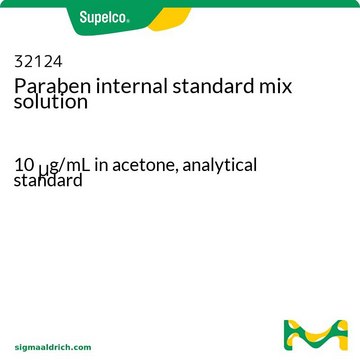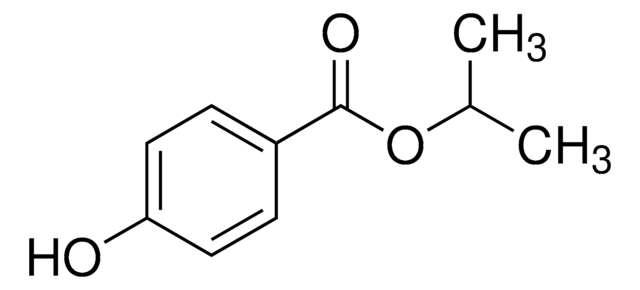47889
Methyl Paraben
PESTANAL®, analytical standard
Sinónimos:
Metil 4-hidroxibenzoato, Éster metílico del ácido p-hidroxibenzoico, Metil parabeno, NIPAGIN
About This Item
Productos recomendados
grado
analytical standard
Nivel de calidad
Línea del producto
PESTANAL®
CofA
current certificate can be downloaded
envase
ampule of 1000 mg
técnicas
HPLC: suitable
gas chromatography (GC): suitable
mp
125-128 °C (lit.)
aplicaciones
cleaning products
cosmetics
food and beverages
personal care
Formato
neat
temp. de almacenamiento
2-30°C
cadena SMILES
COC(=O)c1ccc(O)cc1
InChI
1S/C8H8O3/c1-11-8(10)6-2-4-7(9)5-3-6/h2-5,9H,1H3
Clave InChI
LXCFILQKKLGQFO-UHFFFAOYSA-N
Información sobre el gen
rat ... Ar(24208)
¿Está buscando productos similares? Visita Guía de comparación de productos
Descripción general
Aplicación
Productos recomendados
Información legal
¿No encuentra el producto adecuado?
Pruebe nuestro Herramienta de selección de productos.
Frases de peligro
Consejos de prudencia
Clasificaciones de peligro
Aquatic Chronic 2
Código de clase de almacenamiento
11 - Combustible Solids
Clase de riesgo para el agua (WGK)
WGK 1
Punto de inflamabilidad (°F)
334.4 °F
Punto de inflamabilidad (°C)
168 °C
Equipo de protección personal
dust mask type N95 (US), Eyeshields, Gloves
Elija entre una de las versiones más recientes:
¿Ya tiene este producto?
Encuentre la documentación para los productos que ha comprado recientemente en la Biblioteca de documentos.
Los clientes también vieron
Protocolos
Separation of Uracil; p-Aminobenzoic acid; Acetylsalicylic acid; Dehydroacetic acid; Benzoic acid; Methyl paraben; 3-Fluorobenzoic acid
Separation of Methyl Paraben, analytical standard; Ethylparaben, United States Pharmacopeia (USP) Reference Standard; Propylparaben, United States Pharmacopeia (USP) Reference Standard; Butylparaben, United States Pharmacopeia (USP) Reference Standard
Nuestro equipo de científicos tiene experiencia en todas las áreas de investigación: Ciencias de la vida, Ciencia de los materiales, Síntesis química, Cromatografía, Analítica y muchas otras.
Póngase en contacto con el Servicio técnico







